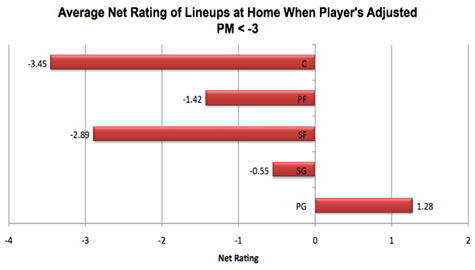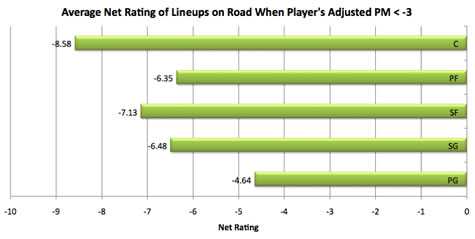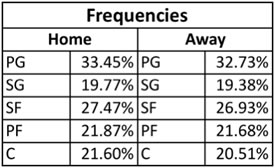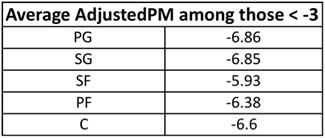| Basketball-Statistics.com | Innovative Stats and Analysis | |||||||||||
|
|||||||||||
|
|
by Jon Nichols In my last study (http://basketball-statistics.com/atwhichpositionsaregreatplayersthemostimportant.html), I looked at the importance of great players to a team’s success. Today, I will be doing the opposite, instead focusing on the weaker players. The methodology is the same, only I will be using players with an Adjusted Plus-Minus below -3 rather than above three. For further details on my methodology, click on the article above. Without further ado, here are the results:
And the home/away splits…
It appears the two positions you don’t want to be weak at are center and small forward. On the other end of the spectrum, it appears you can manage a lot better with a bad point guard. Of course, it’s best to have as many good players as possible, so ideally you don’t have to “deal with” anything. At home, weak players at the guard position don’t appear to be particularly disastrous. In fact, lineups featuring a point guard with an Adjusted Plus-Minus below -3 still on average tend to be better than their opponent. On the road, it hurts much more to have a weak guard, especially a 2-guard. Regardless of location, center and small forward are two positions where you can’t have a struggling player. Just like I did with my last study, I’m going to look at two potential hidden issues. The first is sample size.
There appears to be an adequate amount of bad players at each position to make this study valid. Interestingly, there are more bad players at point guard than at any other position. Originally I would have guessed centers would be the weakest. The next step is to calculate the average Adjusted Plus-Minus for each position among those that qualify. For example, if there are 20 point guards with an Adjusted Plus-Minus of -3.01, that position will look not as important because the players in the study really aren’t that horrible in the first place. What do the numbers say?
With the exception of small forwards and possibly power forwards, the numbers appear to be pretty even across the board. This further supports the evidence that having a weakness at small forward is a major problem. Even though the small forwards in this study weren’t as bad as the other positions, they still had a more negative effect than any other position besides center. Finally, I’d like to relate this back to my original study. As you may recall, I suggested that small forwards and centers (especially on the road) are often the most important players to a team’s success. Today’s results support that assertion. Not only does having good players at these positions greatly improve your team, but having weak players at these positions worsens your team. On the other hand, point guards appear to be much less important. Both good and bad ones have less of an impact. Like I said in the original article, these studies are by no means the final authority. I only looked at two potential complications, and in reality there could be many more. Further studies should isolate the positions further and perhaps explain in more detail why exactly certain positions appear to be more important than others. I would also like to look at the results of previous years, which is something I may get into soon.
Copyright © 2009 Basketball-Statistics.com |
|||||||||




